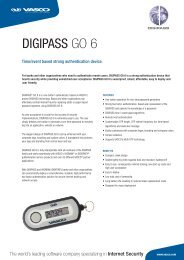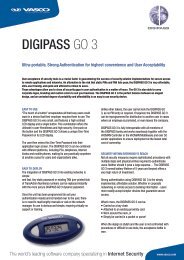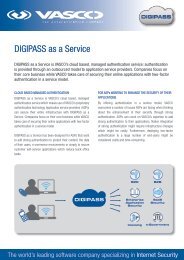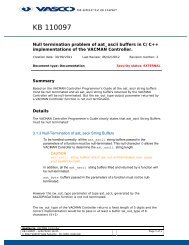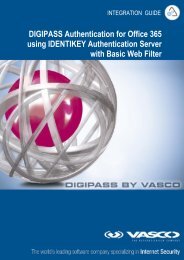Digipass Plug-In for SBR Administrator Reference - Vasco
Digipass Plug-In for SBR Administrator Reference - Vasco
Digipass Plug-In for SBR Administrator Reference - Vasco
Create successful ePaper yourself
Turn your PDF publications into a flip-book with our unique Google optimized e-Paper software.
<strong>Digipass</strong> <strong>Plug</strong>-<strong>In</strong> <strong>for</strong> <strong>SBR</strong> <strong>Administrator</strong> <strong>Reference</strong> <strong>Digipass</strong> TCL Command-Line Administration<br />
14.2 Using DPADMINCMD – Basics<br />
You can use TCL interactively with a command prompt or you can use it to run a script.<br />
14.2.1 Using an <strong>In</strong>teractive TCL Command Prompt<br />
Using DPADMINCMD to open an interactive TCL command prompt can be done as follows:<br />
1. Open a Windows command prompt in the \Bin directory.<br />
2. Enter the following command and press Enter:<br />
dpadmincmd<br />
A command prompt will be opened, at which you can enter TCL commands. DPADMINCMD<br />
automatically loads the VASCO TCL extensions, so that they can be used without needing to<br />
specify the VASCO 'namespace'.<br />
C:\Program Files\VASCO\VACMAN Middleware\Bin>dpadmincmd.exe<br />
<strong>Digipass</strong> TCL Command-Line Administration Version 3.0.0.12<br />
Copyright (C) VASCO Data Security <strong>In</strong>c. 2006<br />
All rights reserved<br />
%<br />
Be<strong>for</strong>e any data administration commands will work, you need to per<strong>for</strong>m an administrative<br />
logon, directly to Active Directory or to the database.<br />
The Active Directory logon does not need explicit credentials if you are logged into Windows as<br />
an administrator with the necessary rights:<br />
% logon<br />
1<br />
%<br />
The ODBC or embedded database logon does need explicit credentials. The Active Directory<br />
logon can also be done with explicit credentials if necessary:<br />
% logon {userid admin password password}<br />
1<br />
%<br />
If the logon is successful, the output indicates a session number. Otherwise, an error message<br />
will be displayed.<br />
Once there has been a successful logon, you can enter other commands, <strong>for</strong> example:<br />
% user query {userid admin}<br />
{domain master userid admin has_dp Unassigned status 0 created {2006/05/11 11:05<br />
:32} modified {2006/05/11 11:05:32}}<br />
%<br />
To log off, use the logoff command; to exit, use the exit command.<br />
© 2006 VASCO Data Security <strong>In</strong>c. 151




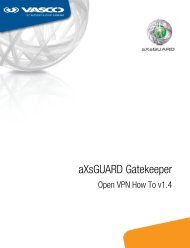
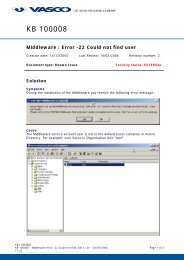
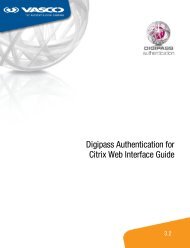
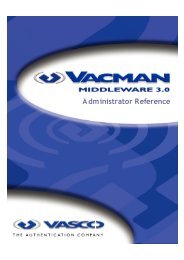
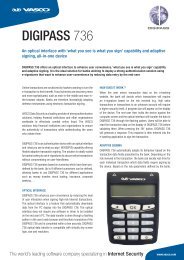
![KB [100006] - Vasco](https://img.yumpu.com/12539350/1/184x260/kb-100006-vasco.jpg?quality=85)

